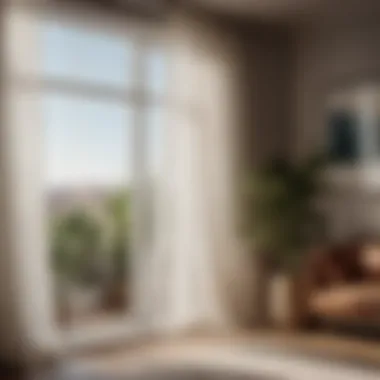Materials:
-
High-quality weather-stripping tape: 10 feet. This tape must securely seal any gaps or openings around the window.
-
Draft stopper: 1 unit. An essential tool to prevent air infiltration through the base of the window.
-
Caulk gun with silicone sealant: 1 unit. The sealant is crucial for filling in any cracks or holes in the window frame.
-
Window insulation kit: 1 kit. Includes insulating plastic film and double-sided tape to improve energy efficiency.
-
Screwdriver set: Ensure you have a variety of screwdrivers for any adjustments needed.
DIY Steps:
-
Begin by inspecting the window for any visible gaps or openings that could allow air leakage. Diagnose any potential weak points before proceeding.
-
Apply the weather-stripping tape along the edges of the window frame, ensuring a tight seal to prevent wind from seeping through.
-
Use the draft stopper to block any drafts sneaking in from the base of the window. Slide it snugly against the bottom to eliminate air flow.
-
Employ the caulk gun loaded with silicone sealant to seal off any cracks or crevices in the window frame. This will further fortify the barrier against wind infiltration.
-
Install the window insulation kit according to the manufacturer's instructions. Create an additional layer of insulation to enhance energy efficiency and minimize wind entry.
Technical Aspects:
- Timing specifics: Allocate a sufficient amount of time to properly seal and insulate the window. Precision is key in achieving effective results.
- Tools: Utilize the screwdriver set for any necessary adjustments during the installation process.
- Critical techniques: When applying the weather-stripping tape and silicone sealant, ensure thorough coverage to maximize effectiveness.
DIY Project Process:


-
Begin by cleaning the window surface to ensure optimal adhesion of the materials used for sealing.
-
Proceed with installing the weather-stripping tape along the perimeter of the window frame, pressing firmly to create a tight seal.
-
Place the draft stopper at the base of the window to eliminate any drafts that may enter from below.
-
Seal off any visible gaps or cracks with the silicone sealant, smoothing it out for a seamless finish.
-
Complete the process by applying the window insulation kit, following the step-by-step guide for proper insulation.
Troubleshooting Tips:


- If drafts persist, double-check the seal on the weather-stripping tape and draft stopper for any gaps.
- Ensure the silicone sealant has fully dried before testing the window for air leakage.
Introduction


The phenomenon of wind coming through a window is a captivating subject that intricately connects architectural design with natural elements. In this article, we will delve into the complexities surrounding this phenomenon, dissecting the various facets that contribute to the wind's entry through windows. By exploring the interplay between window design and environmental factors, we aim to provide a holistic understanding of this intriguing occurrence.
Defining the Phenomenon
Nature of Wind
The nature of wind, characterized by its fluidity and dynamic movement, plays a crucial role in driving air currents into indoor spaces through window openings. This aspect of wind not only influences interior air circulation but also impacts the overall comfort levels within a room. Understanding the behavior of wind is essential for comprehending how it interacts with architectural features like windows, shaping the indoor environment.
Implications of Window Openings
Window openings serve as primary gateways for wind to infiltrate indoor spaces, influencing internal airflow patterns and temperature regulation. The implications of window openings extend beyond mere ventilation, impacting energy efficiency and natural lighting levels within a room. By acknowledging the significance of window configurations and their influence on wind entry, one can harness these implications to optimize indoor environments.
Significance of Understanding
Energy Efficiency
Indoor Air Quality
The influx of wind through windows directly impacts indoor air quality by facilitating air exchange and pollutant dispersion. Proper management of airflow patterns through strategic window placements can enhance ventilation levels, reducing the buildup of pollutants and stale air. Recognizing the correlation between wind entry and indoor air quality is vital for creating a healthy and breathable living environment.
Factors Influencing Wind Entry
When delving into the intriguing phenomenon of wind coming through a window, it is crucial to understand the various factors that influence this occurrence. Factors influencing wind entry play a significant role in shaping the indoor environment and can have implications for energy efficiency and indoor air quality. By exploring the nuances of window design and considering external environmental factors, we can gain a more holistic understanding of why and how wind enters through windows.
Window Design
Ventilation Structure
Ventilation structure is a paramount aspect of window design that greatly impacts the entry of wind into a space. The specific configuration of ventilation openings and the placement of vents can significantly influence the flow of air. A well-thought-out ventilation structure promotes efficient air circulation, enhances indoor air quality, and contributes to maintaining a comfortable environment. The strategic placement of vents allows for the controlled entry of fresh air while preventing drafts or stagnation. Leveraging ventilation structures provides a balance between airflow and insulation, ensuring a harmonious indoor atmosphere.
Orientation
The orientation of windows is another key consideration in influencing wind entry. By aligning windows strategically, homeowners can capitalize on natural ventilation and airflow patterns to optimize thermal comfort and indoor air quality. The orientation of windows determines the amount of sunlight and air exposure a space receives, influencing temperature regulation and energy consumption. Properly oriented windows maximize natural light ingress while minimizing heat gain or loss, promoting a sustainable indoor environment. Considering the orientation of windows is essential in harnessing the benefits of passive ventilation and reducing reliance on mechanical cooling systems.
External Environment
Wind Speed
Wind speed is a critical factor in determining the intensity of airflow through windows. Higher wind speeds can enhance natural ventilation and air movement within a space, promoting effective air exchange and reducing stagnant conditions. Harnessing varying wind speeds can provide opportunities for passive cooling and ventilation, enhancing indoor comfort and decreasing the reliance on mechanical HVAC systems. Understanding the impact of wind speed on indoor airflow helps homeowners make informed decisions about window placement and design to optimize natural ventilation.
Temperature Differentials
Temperature differentials between indoor and outdoor environments influence the direction and intensity of airflow through windows. Disparities in temperature create pressure differentials that drive air movement, affecting the circulation patterns within a space. Leveraging temperature differentials allows for natural ventilation and thermal regulation, enhancing occupant comfort and reducing energy consumption. By considering temperature differentials, homeowners can capitalize on passive heating and cooling strategies, maximizing indoor environmental quality and sustainability.
Mechanisms of Wind Flow
Exploring the topic of Mechanisms of Wind Flow within the context of this article is crucial for a comprehensive understanding of how wind interacts with windows. When delving into the intricate systems that govern wind flow, specific elements such as Pressure Differentials and Air Circulation Patterns play a pivotal role. By dissecting these mechanisms, we can uncover the underlying principles that influence how wind enters spaces through windows, shedding light on the dynamics at work.
Pressure Differentials
Bernoulli's Principle
Bernoulli's Principle stands as a cornerstone in understanding the behavior of wind around structures, including windows. This fundamental concept highlights the relationship between air pressure and velocity, emphasizing how variations in pressure can impact the flow of wind. In the context of this article, Bernoulli's Principle offers insights into how design choices and environmental factors influence the air movement through windows. Recognizing the unique feature of Bernoulli's Principle in relation to wind entry is crucial for optimizing ventilation strategies and enhancing indoor comfort.
Stack Effect
The Stack Effect elucidates how temperature differentials drive airflow within a space, including the movement of wind through windows. This phenomenon relies on warm air rising and cold air sinking, creating a natural circulation pattern that enhances ventilation. Exploring the intricacies of the Stack Effect within the framework of this article allows us to grasp its significance in regulating indoor air quality and temperature. Understanding the advantages and potential limitations of the Stack Effect empowers homeowners to optimize their environmental control measures effectively.
Air Circulation Patterns
Convection Currents
Convection Currents play a vital role in dictating how air moves within a confined area, impacting the flow of wind through windows. By examining the characteristics of Convection Currents, we gain valuable insights into how heat transfer and air circulation contribute to the overall ventilation of a space. In the context of this article, Convection Currents offer a lens through which to understand the role of natural forces in shaping indoor airflow, highlighting the benefits and considerations associated with this mechanism.
Cross-Ventilation
Cross-Ventilation embodies a strategic approach to harnessing wind flow through architectural design, promoting efficient airflow within a building. The unique feature of Cross-Ventilation lies in its ability to enhance air quality and thermal comfort by facilitating the exchange of indoor and outdoor air. Exploring the advantages and potential drawbacks of Cross-Ventilation in the context of this article provides homeowners with actionable insights into optimizing ventilation systems for a healthier and more sustainable living environment.
Impact on Indoor Environment
In the exploration of the phenomenon of wind coming through a window, understanding its impact on the indoor environment is crucial. The elements of thermal comfort and aesthetic considerations play significant roles in creating a pleasant and functional indoor space. By considering these factors, homeowners can optimize their living environment for comfort and well-being.
Thermal Comfort
Temperature Regulation
Temperature regulation is a fundamental aspect of maintaining thermal comfort within a space affected by wind flow through windows. Effective temperature control ensures that the indoor environment remains pleasant and habitable, regardless of external weather conditions. The ability to regulate temperatures allows homeowners to enjoy a consistent and suitable climate indoors, promoting comfort and productivity.
Humidity Levels
Humidity levels also contribute significantly to indoor thermal comfort. Proper humidity control ensures that the indoor air quality remains optimal, preventing issues such as mold growth or discomfort due to excessively dry or damp conditions. Balancing humidity levels enhances the overall comfort of the indoor environment, supporting a healthy and enjoyable living space.
Aesthetic Considerations
Natural Ventilation
Natural ventilation, facilitated by wind entering through windows, offers a unique and energy-efficient method of enhancing indoor air quality. By allowing natural airflow, homeowners can reduce reliance on mechanical systems for air circulation, promoting sustainability and cost efficiency. Natural ventilation also brings a sense of freshness and vitality to the indoor space, improving overall comfort and well-being.
Sense of Connection with Outdoors
The connection with the outdoors fostered by wind coming through windows adds a refreshing and invigorating dimension to indoor spaces. Homeowners can experience a subtle reminder of nature through the gentle breeze and natural scents carried indoors, enhancing the ambiance and mood within the home. This connection with the outdoors promotes a sense of tranquility and harmony, creating a holistic living environment that benefits both physical and emotional well-being.
Mitigation Strategies
Window Modifications
Sealing Techniques:
When it comes to mitigating wind entry through windows, the topic of Sealing Techniques plays a crucial role in enhancing the energy efficiency and comfort of a living space. By focusing on the specific aspect of Sealing Techniques, homeowners and housewives can effectively address air leakage issues and improve thermal insulation. The key characteristic of Sealing Techniques lies in their ability to create a tight seal around window frames, preventing unwanted drafts and outside air infiltration. This feature makes Sealing Techniques a popular choice for this article as it aligns with the goal of optimizing indoor environmental quality. One unique advantage of Sealing Techniques is their versatility in adapting to different window types and sizes while providing a durable barrier against external elements.
Adjustable Vents:
In the realm of Mitigation Strategies, Adjustable Vents emerge as a practical solution for regulating airflow and balancing indoor comfort levels. By delving into Adjustable Vents, individuals can customize the amount of air entering through windows, thereby controlling ventilation and reducing potential air disturbances. The key characteristic of Adjustable Vents is their flexibility in allowing users to adjust airflow according to specific needs and weather conditions, contributing to a more comfortable indoor environment. This adaptable feature makes Adjustable Vents a beneficial choice for this article as it emphasizes the importance of personalized environmental controls. Moreover, the unique advantage of Adjustable Vents lies in their ability to promote natural ventilation without compromising security measures in residential spaces.
Environmental Controls
Shrubbery Placement:
Turning attention to Environmental Controls, Shrubbery Placement emerges as a natural and aesthetically pleasing method to mitigate wind effects around windows. By considering the specific aspect of Shrubbery Placement, homeowners and house owners can strategically position greenery to act as windbreaks and reduce the impact of gusty drafts. The key characteristic of Shrubbery Placement is its ability to create a barrier that redirects wind patterns away from windows, creating a calmer microclimate indoors. This characteristic makes Shrubbery Placement a popular choice for this article as it aligns with enhancing the visual appeal and indoor comfort of living spaces. Additionally, the unique feature of Shrubbery Placement includes its contribution to promoting biodiversity and offering natural shading benefits, although maintenance and potential overgrowth could be considered as disadvantages in certain contexts.
Windbreakers:
In the context of Mitigation Strategies, Windbreakers present a structural solution to minimize wind effects on windows and surrounding areas. By exploring the specific aspect of Windbreakers, individuals can install physical barriers like fences or screens to obstruct strong winds and create a shielded space around windows. The key characteristic of Windbreakers is their ability to break wind gusts and create a more peaceful and controlled environment indoors, reducing noise and potential air disturbances. This feature makes Windbreakers a beneficial choice for this article as it underlines the importance of external interventions in enhancing indoor comfort. Moreover, the unique advantage of Windbreakers lies in their durability and long-term effectiveness in protecting against harsh weather conditions, although limitations in certain design aesthetics or visibility aspects should be considered as potential disadvantages.





